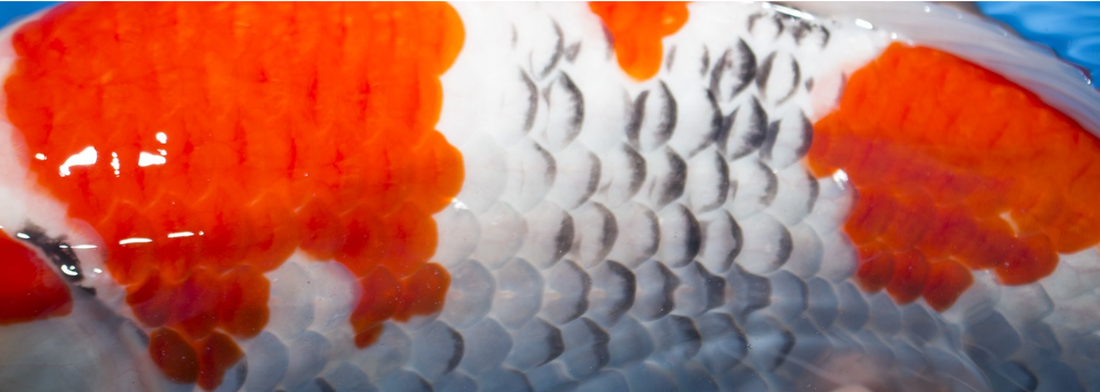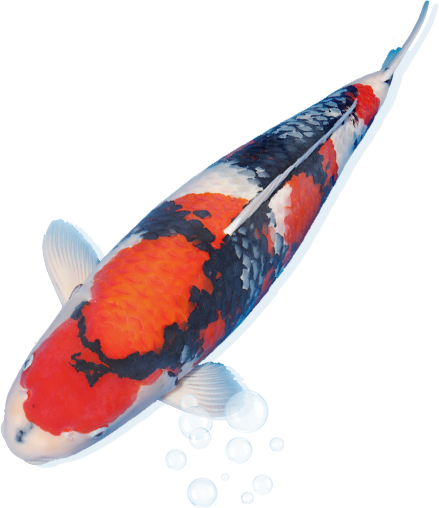
Share
A few weeks ago I sourced a sansai Goshiki for Queni Koi in the UK and although that may not sound very interesting as you can see from the pictures below it’s not just an ordinary example. What makes this even more intriguing is that breeder is Ikarashi Kazuto, a farm renowned for producing top-level Gosanke not Goshiki. This fish has caused quite a stir in Japan and I am going to take this opportunity to explain the qualities of this fish, where I see it heading in future and taking a look at the parent koi to see how the genetics can give an insight into the koi’s future.
Body Shape
When it comes to appreciating this koi a good place to start would be the body because for me when purchasing any koi the body is king. Now Goshiki are not renowned for growing big and ultimately it’s not all about the size but you still want a bone structure that is able to carry volume as the body matures. Goshiki can typically tend to have bodies that can become rounded in the belly region and have smaller heads which leads to shorter bodies which again comes back to their inability to obtain jumbo sizes. The body and bone structure of this fish resembles that of a good Kohaku or Sanke that in conjunction with seeing the female parent koi (more on that topic to follow) are indicators that there’s plenty more growth in both length and volume to come.
Skin Quality
Next on the list comes the skin and there is so much to appreciate here starting with the beni quality which is so important for Goshiki. The thickness and elasticity are very important if the quality is going to be retained as the koi grows bigger and it puts a big tick in both of those boxes. You can determine this by looking at two main points the first one being the sashi (front edge of the scales) which as you can see has a little depth to it and this tells us that there is elasticity in the second layer of the skin to allow the pigment to grow with the fish. The second being the evenness of the colour within each scale because at this age there should still be undeveloped pigmentation within the scales and this can be seen in the form of a thick red line in the middle of each scale, this is a concentration of red pigment. As the koi matures these cells spread into the scale until the colour becomes “finished” at which point the beni will be uniform in it’s appearance.
When evaluating skin quality good kiwa is a must, it should be very sharp especially given the age of this koi and as you can see the definition between the beni and shiroji is very good. The style of kiwa exhibited here is maruzome that forms a scalloped edge and this is consistent throughout the whole body. This kiwa is further enhanced by the quality of the shiroji that is so pure and not commonly found on this variety but actually adds a lot to the koi. In future a lot of this will be covered by the sumi but I suspect that a window of shiroji will remain just behind the head, which will create a truly unique pattern.
Pattern
A koi of this level would not be complete without having a killer pattern and I don’t think you could ask for much more. A very well balanced sandan (3 step) pattern which wraps around the entire body nicely. The traditional and desirable u-shaped head pattern is complimented by the sumi on the nose and great odome at the peduncle to balance it up.
The only part that is currently incomplete is the sumi robing which is known as mameshibori sumi but as you can see from the pictures it is developing. The sumi itself is of a type that develops within the top of the skin rather than being deep rooted like for example Dainichi Showa sumi. What this means is that you won’t see the sumi sat underneath the skin, one day it won’t be there and then the next it will. One point with this sumi is that it develops quickly especially when put into conditions which are conducive to sumi development. So within a short period of time you can expect to see the mameshibori sumi pattern cover most of the koi. There is a chance that the shiroji just behind the head will remain free of this sumi as the white skin in that area is especially thick but in this case I am actually hoping that this happens because it will help to create a truly unique Goshiki and in Japan that it what’s needed to win awards.
Parent Koi / Bloodline
In order to fully support my thoughts on the future of this koi it was important to try and find out as much information as possible from the breeders about the parent koi and bloodlines. Ikarashi San was incredibly helpful in this department providing a full history and some fascinating pictures.
The female oyagoi (parent koi) originated in Koguriyama village where Hiroi Koi Farm currently resides, a very famous Goshiki breeder. The female however did not originate from Hiroi as Ikarashi san explained that many years ago that area was famous for producing Goshiki and there were many farms producing them so the exact origin was unknown. When they obtained the female oyagoi it was 65cm and now at 22 years old it is 79cm and still growing a little each year which is good considering that it permanently resides in a mud pond so it relies on natural food most of the time. What is really great to see from the pictures below is how the qualities of this Goshiki clearly resemble that of the female oyagoi
The male fish used come from Kanno and Hiroi but Ikarashi san could not be sure which fish it would be exactly as they use the natural spawning method. What is clear is that the quality of the female fish is exceptional. The picture below shows the fish in 2002 and then just before spawning this season, some 12 years later. You can clearly see it retains the excellent beni and shiroji quality throughout it’s life. It’s truly fascinating to get this kind of insight and I can’t wait to see what the future brings for this koi.
With high quality koi there is a lot to understand and appreciate and when all of these elements come together the result is something truly stunning like this Goshiki.
Written by Ricky Stoddart of Koi Wholesale and KoiTalk.com

